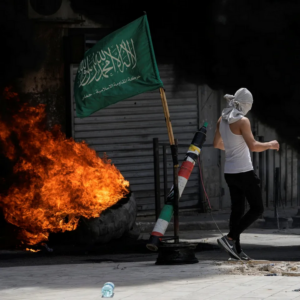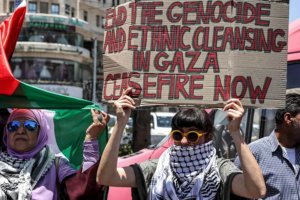How popular is Hamas, in Gaza and outside of it after nine months of war?

A masked Palestinian demonstrator burning tyres next to a mock rocket and the Hamas flag during clashes with Israeli forces in Jenin in May 2024
Dahlia Scheindlin writes in Haaretz on 17 July 2024:
Some of the details are still murky, but a few things about what happened to Amin Abed are clear. Abed is an activist in Gaza who repeatedly criticized Hamas, and condemned the attacks of October 7, in long Facebook posts.
Last week, he was snatched and beaten by a gang of masked men wielding guns and machetes, he told the BBC. The men said they were from Hamas security forces, and one of them instructed the thugs to break all of Abed’s fingers. Abed’s supporters then circulated pictures of him on social media, slumped over in the hospital, with every visible limb in a cast, to indicate their disgust at Hamas.
Other Gazans didn’t need to have their bones smashed to start detesting Hamas. In a May survey by the Arab World Research and Development group from Ramallah, just one quarter of Gazans said they had “positive” feelings about Hamas’ role (24 percent) – a 36-point plunge from AWRAD’s November survey asking the same question. The collapse of support in Gaza dragged the whole average (of Palestinians in the West Bank, Jerusalem and Gaza) down by more than 20 points, to 55 percent who rated Hamas’ role positively now, compared to 76 percent in November. Three quarters of West Bank respondents still view Hamas’ role positively.
The findings from three prominent polling agencies differ significantly. These include Khalil Shikaki’s veteran Palestinian Center for Policy and Survey Research (PSR for short – disclosure: we conduct research together); AWRAD; and relative newcomer the Institute for Social and Economic Progress. PSR’s surveys continue to show robust support for Hamas: nearly two-thirds in Gaza assessed Hamas’ role positively in June, and nearly half of Gazans (46 percent) said they would prefer Hamas to control Gaza after the war – the top choice of seven options. ISEP’s survey found that just under 5 percent of Gazans chose Hamas in a similar question with four options. Extreme duress and war make it tough to get consistent results.
Even with huge differences between them, two points seem clear from recent surveys: the chasm between the West Bank and Gaza is steady and vast; and by certain measures, in Gaza at least, Hamas’ temporary rise is falling.
No mystery
It isn’t hard to guess why. In May, AWRAD’s survey asked whether things in Palestine are going in the right or wrong direction: 70 percent of Gazans said “wrong”; just 27 percent said “right.”
Mkhaimar Abusada, a political scientist from Gaza who evacuated to Cairo during the war and spoke to me by Zoom, nodded knowingly upon hearing that result. He believed the “direction” question represented a proxy measure of core support for Hamas. “The 27 percent [saying Palestine is going in the right direction] are probably Hamas supporters who think these battles will lead to the liberation of Palestine,” he said. Hamas’ base of support is about 25 or 30 percent in Gaza, he believes, a figure other analysts cited as well. That’s close to one prewar measure: Last September, PSR found that “27 percent believe that Hamas is the most deserving of representing and leading the Palestinian people today.”
As for the 70 percent of Gazans in AWRAD’s poll who said things were going wrong: “If you look at Gaza, with 80 percent of homes destroyed, no schools, no universities, no electricity lines, no basic services, how could you say things are going in a positive way?” Abusada asked, noting that more than 650,000 schoolchildren and 100,000 higher education students lost a school year, and 1.8 million people are displaced – not to mention the dead. “The only people who believe things going well,” he said, are “those who believe in fantasies, mythical things, religious beliefs.”
Abusada also said that approximately 100,000 Gazans have left since the start of the war, citing information from the Palestinian embassy in Cairo. Many were middle class, businesspeople or academics like him, who could afford the exorbitant fees needed to flee. Like the dead, they too are not represented in surveys.
Supporting the indefensible – out of desperation

Palestinians gathering for a protest in support of Gaza, in Ramallah, June 2024
All that doesn’t negate the toughest findings from the Israeli perspective. PSR’s early polls found that over 70 percent of Palestinians thought Hamas was “correct to attack,” which has become a household data point among Israelis.
Back in November, Palestinians explained to me that in the earliest hours, many hoped the attack would herald liberation and tried to avoid, or evade, knowing about the atrocities. That’s still the case, according to PSR’s surveys that continue to show that roughly 90 percent have not seen video evidence of atrocities and do not believe they were committed.
But again, the gap between the West Bank and Gaza is striking. In the June PSR survey, 57 percent in Gaza supported Hamas’ decision to attack, compared to 73 percent in the West Bank. One explanation for this support is the towering consensus that Palestinians are back on the map: 82 percent of respondents in PSR’s June survey say the attack “revived international attention to the Israeli-Palestinian conflict and that it could lead to increased recognition of Palestinian statehood.” This is empirically true.
“I truly believe Palestinians don’t support killing civilians or children – what they support is the prison break,” Obada Shtaya told me in a call. Shtaya (no relation to the former Palestinian prime minister) co-founded the ISEP group in 2023. The attack “stopped the phenomenon of ongoing occupation with no one paying attention, which went on for a very long time,” he said.
It’s a short leap from frustration to desperation. Rula Hardal is a political scientist and co-director of the A Land for All movement (where I am a board member), as well as a fellow at the Shalom Hartman Institute in Jerusalem. She is also an Israeli citizen (“a ’48 Palestinian”) living in the West Bank. In her view, “despite the high support [West Bankers] still show, it’s not that they love Hamas. It’s the helplessness. Hamas represents what they dream of – a bit of dignity, liberation and end of occupation – by contrast to those who have no political vision.”
“Helplessness” is a standout finding in ISEP’s polling. Last October, one-third of West Bankers chose this as their main emotion (the highest-ranked option); by June, 53 percent of West Bank respondents chose “helplessness” in the ISEP poll. That makes sense: life in the West Bank is frankly awful. Movement is almost impossible. Hardal recalled driving six kilometers (nearly four miles) that took nearly three hours due to tight Israeli road restrictions and checkpoints. Many are effectively locked into the main cities – literally, with iron gates. Israeli authorities have slashed water availability, said Shikaki, in the blistering summer heat.
All this is only the culmination of a particularly terrible year in the West Bank; 2023 was a time of rampant settler violence, attacks on Palestinian towns and an extremist Israeli government. Ahead of Israel’s last Knesset election, 35 percent of West Bank respondents supported armed struggle as the means to end the occupation in PSR’s surveys. A year later, just ahead of Hamas’ attack, support rose over 20 points, to 54 percent.
Who pays the price?
The most common explanation for why so many more Gazans resent Hamas is clear: In the West Bank, said Shikaki, “it’s cost-free to sympathize – you can’t do anything to help Gaza [from here] but you can express emotional, cognitive support.” Next is sheer loathing for Palestinian President Mahmoud Abbas and the Palestinian Authority. The numbers show a consistent consensus of Palestinians who want him out of office. Only in Gaza does the PA get a few more points on certain limited measures – a grim testament to their misery under Hamas. Abusada recalled that Hamas distributed food baskets for the first few weeks of the war (perhaps hinting how long Hamas thought it would last). By June, the AWRAD survey found that just 2 percent chose Hamas as the body they trusted to supply humanitarian aid, compared to 21 percent for the PA.
Shtaya recalled that when Palestinian prisoners were released to the West Bank in the hostage release deal in November, Palestinians there celebrated. But others grumbled about whether the celebrations were justified for a few people when 10,000 had been killed in Gaza by then. That number sounds quaint now.
Moral support or a disconnect?
These realities create a jarring contrast to pro-Palestinian conversations abroad – specifically, the widespread valorization of what Palestinians everywhere call the “resistance.” What about the mission of decolonization, anti-settler colonialism, “from the river to the sea” concepts sweeping pro-Palestinian communities in Western countries and college campuses?
Both Shikaki and Hardal believe the anti-colonial and liberation rhetoric reflected Palestinian political trends of the last century, ending somewhere between the 1960s and the ’80s when the Palestine Liberation Organization declared support for a state within the areas Israel occupied in 1967.
Hardal was blunt about the political misfire of diaspora communities. Many simply “don’t know the reality of the situation,” she said. “There’s a paternalistic element that ‘we want to liberate Palestine, but you’ll pay the price and continue to suffer.'” She believed that position also raises “moral-ethical issues.” Hardal asked rhetorically: “Are you proposing the elimination of the Jewish Israeli people? And how does that fit with your values as a liberation movement, and with global, universal values and standards?”
After all, Hamas at least declared its acceptance of a state in the ’67 areas, and has recently indicated that it’s not particularly invested in continued rule over Gaza (if so, it’s hard to think of a more cynical position at present). Hamas would even consider disarming for the sake of political inclusion. Palestinian opinion on two states varies sharply in the surveys covered here, but Abusada believes that in a general way, 80 percent of Palestinians would accept it if their leaders took the leap.
For Palestinian diaspora communities outside of Gaza, he said, in “Europe, the U.S., Jordan, the West Bank or Qatar, it’s very convenient to speak about resistance … because they’re not paying the price.” Gazans running from tent to tent, waiting on line for bathrooms and bread, are “tired, exhausted … they want an end, any peace deal that would end the ongoing suffering among Palestinians.”
The takeaways are unfair, but at least equally so: Israelis who refused to address Palestinian claims before October 7 must confront Palestinian support for the horror that broke the stalemate. The fact that many Palestinians now despise Hamas could be exploited by Israelis as vindicating the war. And exhilarated pro-Palestinians abroad need to check their valorization of resistance if they truly believe that Palestinian lives matter.
This article is reproduced in its entirety
